模板指令
# 模板指令
# 系统指令:
| 指令名称 | 可用页面 | 描述 |
|---|---|---|
| #checkedIf() | 任意 | 用于输出 "checked" 字符内容,用于在 checkbox 等标签属性里 |
| #selectedIf() | 任意 | 用于输出 "selected" 字符内容,用于在 select 下拉菜单属性里 |
| #maxLength() | 任意 | 用于对字符串内容截取 |
| #hasAddon() | 任意 | 用于检测是否安装、并启用了某个插件 |
| #para() | 任意 | 用于接收 url 的参数内容 |
| #option() | 任意 | 读取后台的配置信息 |
# #checkedIf() 的使用
- checkedIf() 主要用在 checkbox 或者 radio 等标签属性里,支持的参数只能有 true 和 false。
示例:
<input type="radio" name="..." value="text" #checkedIf(type !=null && type== "text")>
- 此时,当 后端输出的
type值等于 “text” 的时候,该单选框就会被选中。
# #selectedIf() 的使用
- 其用法与
#checkedIf()一直,只是 #checkedIf() 用在<option><select ...></option>里。
# #maxLength() 的使用
- maxLength()主要用于限制一些文本的输出长度
例如:
<td>#maxLength(entry.text ??,10)</td>
2
- 此时 不管 entry.text 的文本长度又多少 都只会输出 10 个字符 比如有 100 个字符 但是只会输出 10个字符
# #hasAddon() 的使用
- 用于检测是否安装、并启用了某个插件
示例:
<div>
<!--可以这样直接使用-->
#hasAddon("key") #end
<!--可以这样将结果输出-->
#(hasAddon("key"))
<!--也可以搭配这其它指令一起使用-->
#if(hasAddon("key"))
...
#end
</div>
2
3
4
5
6
7
8
9
10
11
12
13
14
15
16
# #para() 的使用
- 用于接收 url 的参数内容
示例:
<div>
<p>#para("username")</p>
</div>
2
3
4
5
6
7
- 此时 如果当前页面的 URL 是 www.jpress.cn?username="zhangsan" 那么就会获取并输出 zhangsan
# #option() 的使用
- 读取后台的配置信息
示例:
<div>
<p>#option("web_template")</p>
</div>
2
3
4
5
6
7
- 此时 如果在后台有配置过 key 为 web_template 的信息 那么就能得到对应的 value
# 文章相关指令:
| 指令名称 | 可用页面 | 描述 |
|---|---|---|
| #article() | 任意 | 用于读取特定的单篇文章 |
| #articles() | 任意 | 用于读取文章列表,例如:热门文章文章、最新评论文章列表等等 |
| #tagArticles() | 任意 | 读取某个tag下的文章列表 |
| #categoryArticles() | 任意 | 读取某个分类下的文章列表 |
| #articlePage() | 任意 | 用于对文章列表进行的内容和分页进行显示 |
| #commentPage() | 文章详情:article.html | 用于对文章评论的内容和分页进行显示 |
| #nextArticle() | 文章详情:article.html | 下一篇文章 |
| #previousArticle() | 文章详情:article.html | 上一篇文章 |
| #relevantArticles() | 文章详情:article.html | 相关文章列表,相同标签的的文章 |
| #categories() | 任意 | 读取文章模块的所有分类 |
| #tags() | 任意 | 用于读取文章标签 |
| #articleCategories() | 任意 | 用于读取某一篇文章的所属分类,例如:文章的标签、文章的分类等 |
| #comments() | 任意 | 读取所有评论 |
| #userArticles() | 任意 | 读取某个用户的投稿文章内容 |
| #articleSearchPage() | 搜索结果:artsearch.html | 用户显示搜索结果 |
| #articleCrumb() | 文章相关页面:artsearch.html,article.html | 面包屑 |
# #article() 的使用
- 根据文章 ID 或者 slug 读取文章数据
示例:
<div>
#article("1")
#(article.title ??)
#end
</div>
2
3
4
5
6
7
8
9
10
11
此时 会根据 ID 查询文章信息 并返回一个名为 article 的对象
# #article() 中支持的参数:
- 参数一:文章ID 或者 slug
# #articles() 的使用
- 查询文章列表
示例:
<div>
#articles(flag = "xxx",style = "xxx",hasThumbnail = false,orderBy = "id desc",count = 1,withRecommend=,withTop=false,withHot=false,withLeadNews=false)
#for(article :articles)
<a href="#(article.url)">#(article.title ??)</a>
#end
#end
</div>
2
3
4
5
6
7
8
9
10
11
12
13
此时 会根据提供的条件查询文章信息 并返回一个名为 articles 的 list 对象
# #articles() 中支持的参数:
- flag:文章 flag(标识)
- style:文章 style(样式)
- hasThumbnail:是否有缩略图 boolean类型
- orderBy:根据属性进行排序 例如 "id desc"
- count:需要查询的数量
- withRecommend:是否推荐文章 boolean类型
- withTop:是否置顶文章 boolean类型
- withHot:是否热门文章 boolean类型
- withLeadNews:是否是头条 boolean类型
- withSite:读取哪些站点的内容,不传入默认为当前站带你,传入 * 为所有站点,可以传入站点 id,例如: withSite = "1,2,3"
# #tagArticles() 的使用
- 根据文章分类的 slug 查询文章列表
示例:
<div>
#tagArticles(tag="jpress",hasThumbnail = false,orderBy = "id desc",count = 1)
#for(article : articles)
<a href="#(article.url)">#(article.title ??)</a>
#end
#end
</div>
2
3
4
5
6
7
8
9
10
11
12
此时 会根据提供的条件查询文章信息 并返回一个名为 articles 的 list 对象
# #tagArticles() 中支持的参数:
- tag:文章分类的 slug
- hasThumbnail:是否有缩略图 boolean类型
- orderBy:根据属性进行排序 例如 "id desc"
- count:需要查询的数量
# #categoryArticles() 的使用
- 读取某个分类下的文章列表
示例:
<div>
#categoryArticles(categoryId = 1,orderBy="id desc",count = 3)
#for(article : articles)
<a href="#(article.url ??)">#(article.title ??)</a>
#end
#end
</div>
2
3
4
5
6
7
8
9
10
11
12
此时 会根据提供的条件查询文章信息 并返回一个名为 articles 的 list 对象
# #categoryArticles() 中支持的参数:
- categoryId:文章分类的ID
- categoryFlag:文章分类的标识
- hasThumbnail:是否有缩略图 boolean类型
- orderBy:根据属性进行排序 例如 "id desc"
- count:需要查询的数量
- withRecommend:是否推荐
- withTop:是否指定
- withHot:是否热门
- withLeadNews:是否头条
- includeChildren:是否包含子分类内容
# #articlePage() 的使用
- 用于对文章列表进行的内容和分页进行显示
示例:
#articlePage()
#for(article : articlePage.list)
<div class="ll-card">
<div class="row">
<div class="col-lg-3 col-md-3 col-sm-12 ll-card-image">
<a href="#">
<img src="#(article.thumbnail ?? 'img/default-img.jpg')" class="img-fluid" alt="#(article.title ??)">
</a>
</div>
<div class="col-lg-9 col-md-9 col-sm-12 ll-card-main">
<a href="#(article.url ??)">
<div>
<h3 class="ll-card-main-title">
#(article.title ??)
</h3>
<p class="ll-card-main-info">
#maxLength(article.text,100)
</p>
</div>
<div class="ll-card-tag">
<div><i class="fa fa-clock-o"></i>#date(article.created)</div>
<div><i class="fa fa-eye"></i>#(article.view_count)</div>
<div><i class="fa fa-commenting-o"></i>#(article.comment_count)</div>
</div>
</a>
</div>
</div>
</div>
#end
#articlePaginate(firstGotoIndex=true)
<nav aria-label="Page navigation example">
<ul class="pagination justify-content-center ">
#for(page : pages)
<li class="page-item #(page.style ??)">
<a class="page-link" href="#(page.url ??)">
#(page.text ??)
</a>
</li>
#end
</ul>
</nav>
#end
#end
2
3
4
5
6
7
8
9
10
11
12
13
14
15
16
17
18
19
20
21
22
23
24
25
26
27
28
29
30
31
32
33
34
35
36
37
38
39
40
41
42
43
44
45
46
47
此时 会根据提供的条件查询文章信息 并返回一个名为 articlePage 的 page 对象 内部又包含了另一个指令 #articlePaginate(),#articlePaginate()是用于显示上一页和下一页
# #articlePage() 支持的参数有
- categoryId 文章分类的ID
- pageSize 用来指定当前页面有多少条数据,默认值为10,也就是不填写这个参数的话,默认为10条数据
- orderBy 根据属性进行排序 例如 "id desc"
# 分页指令 #articlePaginate() 的参数有
- previousClass :上一页的样式,默认值:previous
- nextClass :下一页的样式,默认值:next
- activeClass :当前页面的样式,默认值:active
- disabledClass :禁用的样式(当下一页没有数据的时候,会使用此样式),默认值:disabled
- anchor :锚点链接
- onlyShowPreviousAndNext :是否只显示上一页和下一页(默认值为false,一般情况下在手机端才会把这个值设置true)
- previousText :上一页按钮的文本内容,默认值:上一页
- nextText :下一页按钮的文本内容,默认值:下一页
- firstGotoIndex : 是否让第一页进入首页,默认值:false
# #commentPage() 的使用
- 用于对文章评论的内容和分页进行显示
此指令 用于文章详情:article.html 需在对应的 controller 中传入当前的 article 对象 以获取该文章的评论内容
用法与 #articlePage() 类似 也同样 内部又包含了另一个指令 #commentPaginate(),#commentPaginate()是用于显示上一页和下一页
# #commentPage() 支持的参数有
- article:文章对象
- pageSize:用来指定当前页面有多少条数据,默认值为10,也就是不填写这个参数的话,默认为10条数据
# 分页指令 #commentPaginate() 的参数有
- previousClass :上一页的样式,默认值:previous
- nextClass :下一页的样式,默认值:next
- activeClass :当前页面的样式,默认值:active
- disabledClass :禁用的样式(当下一页没有数据的时候,会使用此样式),默认值:disabled
- anchor :锚点链接
- onlyShowPreviousAndNext :是否只显示上一页和下一页(默认值为false,一般情况下在手机端才会把这个值设置true)
- previousText :上一页按钮的文本内容,默认值:上一页
- nextText :下一页按钮的文本内容,默认值:下一页
- firstGotoIndex : 是否让第一页进入首页,默认值:false
# #nextArticle() 的使用
- 用于获取下一篇文章
示例:
<div>
#nextArticle()
<a href="#(next.url)">#(next.title ??)</a>
#end
</div>
2
3
4
5
6
7
8
此指令 用于文章详情:article.html
# #previousArticle() 的使用
- 用于获取上一篇文章
示例:
<div>
#previousArticle()
<a href="#(previous.url)">#(previous.title ??)</a>
#end
</div>
2
3
4
5
6
7
8
此指令 用于文章详情:article.html
# #relevantArticles() 的使用
- 查询相关文章列表,相同标签的的文章
示例:
<div>
#relevantArticles(article,5)
#for(article :relevantArticles)
<a href="#(article.url)">#(article.title ??)</a>
#end
#end
</div>
2
3
4
5
6
7
8
9
10
11
12
此指令 用于文章详情:article.html 此时会根据传入的信息 查询相关文章信息 返回名为 relevantArticles 的 list 对象
# #relevantArticles() 支持的参数有
- article:文章对象
- count:需要查询的数量
# #categories() 的使用
- 读取文章模块的所有分类
示例:
<div>
#categories(flag = "jpress",parentFlag="parent",parentId = 1,asTree = false)
#for(category : categories)
<a href="#(category.url)">#(category.title ??)</a>
#end
#end
</div>
2
3
4
5
6
7
8
9
10
11
12
此时 会根据传入的信息 查询 文章的所有分类信息 返回名为 categories 的 list 对象
# #categories() 支持的参数有
- flag:文章标识
- parentFlag:父级文章标识
- parentId:父级ID
- asTree 是否以树状的数据格式返回,默认是false,返回全部分类,可通过 item.childs 方式获取子级分类列表
# #tags() 的使用
- 用于读取文章标签
示例:
<div>
#tags(orderBy = "id desc",count = 1)
#for(tag : tags)
<a href="#(tag.url)"> #(tag.title ??)</a>
#end
#end
</div>
2
3
4
5
6
7
8
9
10
11
12
此时 会根据传入的信息 查询 文章的所有分类信息 返回名为 tags 的 list 对象
# #tags() 支持的参数有
- orderBy:根据属性进行排序 例如
created desc默认值为id des - count:需要查询的数量 默认值为 10
# #articleCategories() 的使用
- 用于读取某一篇文章的所属分类,例如:文章的标签、文章的分类等
示例:
<div>
#articleCategories(1,"category")
#for(category : categories)
<a href="#(category.url)">#(category.title ??)</a>
#end
#end
</div>
2
3
4
5
6
7
8
9
10
11
12
此时 会根据传入的信息 查询 文章的分类信息 返回名为 categories 的 list 对象
# #articleCategories() 支持的参数有
- 参数一:文章ID
- 参数二:分类的 type
# #comments() 的使用
- 读取所有评论
示例:
<div>
#comments(orderBy = "id desc",count = 1)
#for(comment : comments)
#(comment.title ??)
#end
#end
</div>
2
3
4
5
6
7
8
9
10
11
12
此时 会根据传入的信息 查询所有的评论信息 返回名为 comments 的 list 对象
# #comments() 支持的参数有
- orderBy:根据属性进行排序 例如
created desc默认值为id des - count:需要查询的数量 默认值为 10
# #userArticles() 的使用
- 读取某个用户的投稿文章内容
示例:
<div>
#userArticles(userId = 1,orderBy = "id desc",status ="normal",count = 5,withRecommend=,withTop=false,withHot=false,withLeadNews=false)
#for(article : articles)
#(article.title ??)
#end
#end
</div>
2
3
4
5
6
7
8
9
10
11
12
此时 会根据传入的信息 查询所有的评论信息 返回名为 articles 的 list 对象
# #userArticles() 支持的参数有
- userId: 用户id 可以直接传入 也可通过 controller 传入 user 对象 会自动获取 user 对象的 id 信息
- status:文章状态 例如
status ="normal" - orderBy:根据属性进行排序 例如
created desc默认值为id des - count:需要查询的数量 默认值为 10
- withRecommend:是否推荐文章 boolean类型
- withTop:是否置顶文章 boolean类型
- withHot:是否热门文章 boolean类型
- withLeadNews:是否是头条 boolean类型
# #articleSearchPage() 的使用
- 用户显示文章搜索结果
示例:
<div>
#articleSearchPage()
#for(article : articlePage.list)
<div class="ll-card">
<div class="row">
<div class="col-lg-3 col-md-3 col-sm-12 ll-card-image">
<a href="#">
<img src="#(article.thumbnail ?? 'img/default-img.jpg')" class="img-fluid"
alt="#(article.title ??)">
</a>
</div>
<div class="col-lg-9 col-md-9 col-sm-12 ll-card-main">
<a href="#(article.url ??)">
<div>
<h3 class="ll-card-main-title">
#(article.title ??)
</h3>
<p class="ll-card-main-info">
#maxLength(article.text,100)
</p>
</div>
<div class="ll-card-tag">
<div><i class="fa fa-clock-o"></i>#date(article.created)</div>
<div><i class="fa fa-eye"></i>#(article.view_count)</div>
<div><i class="fa fa-commenting-o"></i>#(article.comment_count)</div>
</div>
</a>
</div>
</div>
</div>
#end
#articleSearchPaginate(firstGotoIndex=true)
<nav aria-label="Page navigation example">
<ul class="pagination justify-content-center ">
#for(page : pages)
<li class="page-item #(page.style ??)">
<a class="page-link" href="#(page.url ??)">
#(page.text ??)
</a>
</li>
#end
</ul>
</nav>
#end
#end
</div>
2
3
4
5
6
7
8
9
10
11
12
13
14
15
16
17
18
19
20
21
22
23
24
25
26
27
28
29
30
31
32
33
34
35
36
37
38
39
40
41
42
43
44
45
46
47
48
49
50
51
此指令 用于搜索结果页:artsearch.html 需在对应的 controller 中传入 keyword(搜索关键字) 以及 page(页码) 信息
用法与 #articlePage() 类似 也同样 内部又包含了另一个指令 #articleSearchPaginate(),#articleSearchPaginate()是用于显示上一页和下一页
# #articleSearchPage() 支持的参数有
- pageSize:用来指定当前页面有多少条数据,默认值为10,也就是不填写这个参数的话,默认为10条数据
# 分页指令 #articleSearchPaginate() 的参数有
- previousClass :上一页的样式,默认值:previous
- nextClass :下一页的样式,默认值:next
- activeClass :当前页面的样式,默认值:active
- disabledClass :禁用的样式(当下一页没有数据的时候,会使用此样式),默认值:disabled
- anchor :锚点链接
- onlyShowPreviousAndNext :是否只显示上一页和下一页(默认值为false,一般情况下在手机端才会把这个值设置true)
- previousText :上一页按钮的文本内容,默认值:上一页
- nextText :下一页按钮的文本内容,默认值:下一页
- firstGotoIndex : 是否让第一页进入首页,默认值:false
# #articleCrumb() 的使用
- 用于显示面包屑
示例:
<div>
#articleCrumb(aClass = "class",indexUrl="/",indexText="首页")
</div>
2
3
4
此时 就会在页面中显示 相关的面包屑
# #articleCrumb() 支持的参数有
- aclass:a标签的 class
- indexUrl:首页的 URL
- indexText:首页的显示文字
# 表单相关指令:
| 指令名称 | 可用页面 | 描述 |
|---|---|---|
| #formInfo() | 任意 | 用于读取相关表单数据 |
# #formInfo() 的使用
- 用于读取相关表单数据
示例:
<div class="jpress-form-content">
#formInfo(id = 1,flag="jpress",withForm =
true,formClass="formInfo",formMethod="post",submitText="提交",submitClass="class")
</div>
2
3
4
5
此时 会根据提供的信息 来查找对应的 form 信息 并显示在页面中
# #formInfo() 支持的参数有
- id: 表单ID
- flag:表单标识
- withForm:如果为 true 则在表单中 会生成提交按钮 提供提交数据功能 等 如果为 false 则生成的表单中 返回的数据 只能做展示功能 不提供修改 提交等功能 默认值为 true
- formClass:可自定义表单的 class 内容
- formMethod:可自定义表单的 提交类型
- submitText:当 withForm 为 true 时生效 可自定义提交按钮的 value值
- submitClass:当 withForm 为 true 时生效 可自定义提交按钮的 class
# 招聘相关指令:
| 指令名称 | 可用页面 | 描述 |
|---|---|---|
| #jobAddress() | 任意 | 用于读取招聘相关地址列表 |
| #jobCategories() | 任意 | 用于读取招聘相关分类列表 |
| #job() | 任意 | 用于读取招聘相关岗位信息 |
| #jobs() | 任意 | 用于查询相关岗位列表 |
| #jobPage() | 岗位列表页:joblist.html | 用于对岗位列表进行的内容和分页进行显示 |
# #jobAddress() 的使用
- 此指令是在任何页面,用来读取岗位的地址列表
<div>
#jobAddress()
<select>
#for(item : addressList)
<option value="#(item.id ??)">#(item.name ??)</option>
#end
</select>
#end
</div>
2
3
4
5
6
7
8
9
10
此时就会根据提供的信息 查询数据 返回名为 addressList 的 list 对象
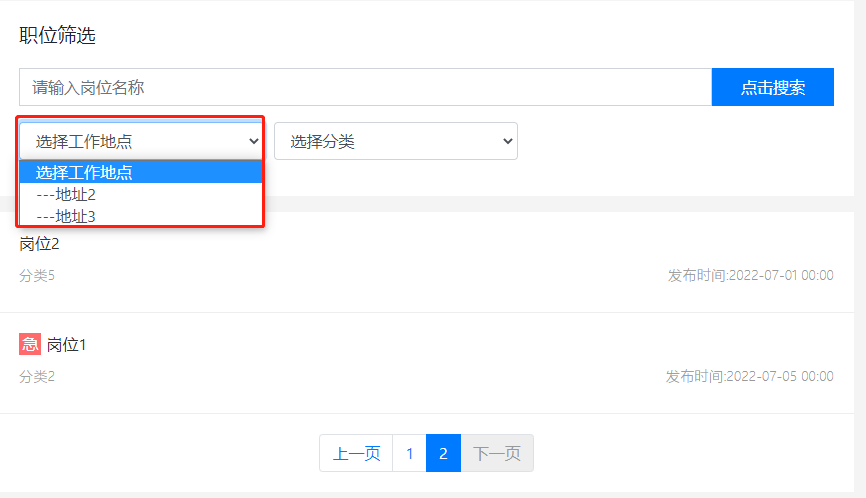
# #jobCategories() 指令的用法
- 此指令用来读取岗位的分类列表
<div>
#jobCategories(parentId = id,isTree= false)
<select>
#for(item : categoryList)
<option value="#(item.id ??)">#(item.name ??)</option>
#end
</select>
#end
</div>
2
3
4
5
6
7
8
9
10
此时就会根据提供的信息 查询数据 返回名为 categoryList 的 list 对象
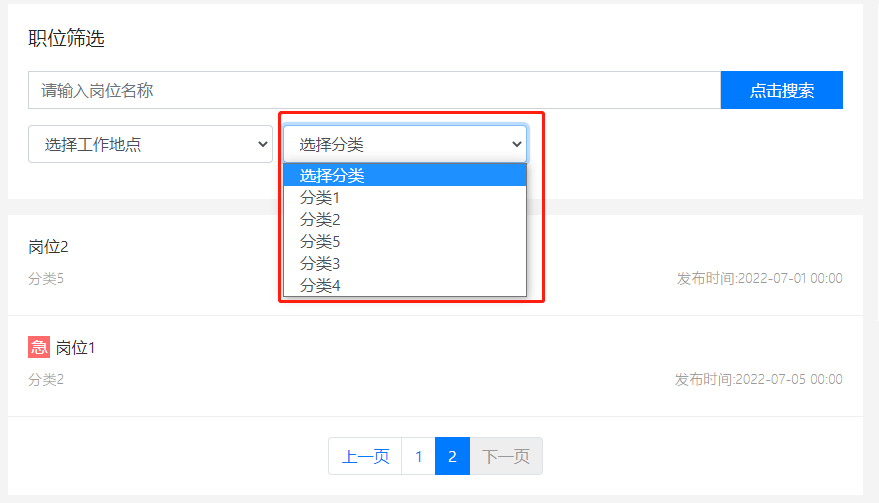
# #jobCategories() 中支持的参数有:
- parentId:读取指定父级分类
- isTree:是否以树状的数据格式返回,默认是false,返回全部分类,可通过 item.childs 方式获取子级分类列表
# #job() 指令的用法
- 此指令是根据岗位ID来查找岗位信息
<div>
#job(1)
<p>#(job.name ??)</p>
<p>#(job.category.name ??)</p>
<p>#(job.address.name ??)</p>
<p>...</p>
#end
</div>
2
3
4
5
6
7
8
9
此时就会根据 提供的信息 查询数据 返回一个名为 job 的 job 对象
# #job() 中支持的参数有:
- id:岗位的id,直接输入id即可
- 查询出来的对象中内置了该岗位对应的:
- category 分类对象信息,使用job.category 即可获得
- address 地址对象信息,使用job.address 即可获得
# #jobs() 指令的用法
- 此指令是根据自定义条件来查询岗位列表信息
<div>
#jobs(categoryId = 1,deptId = 1,addressId = 1,education = 1,workYear = 1,workType = 1,recruitmentType = 1,
orderBy = "id desc",count = 10)
#for(item : jobList)
<p>#(item.name ??)</p>
<p>#(item.category.name ??)</p>
<p>#(item.dept.name ??)</p>
<p>#(item.address.name ??)</p>
<p>....</p>
#end
#end
</div>
2
3
4
5
6
7
8
9
10
11
12
此时就会根据 提供的信息 查询数据 返回一个名为 jobList 的 list 对象
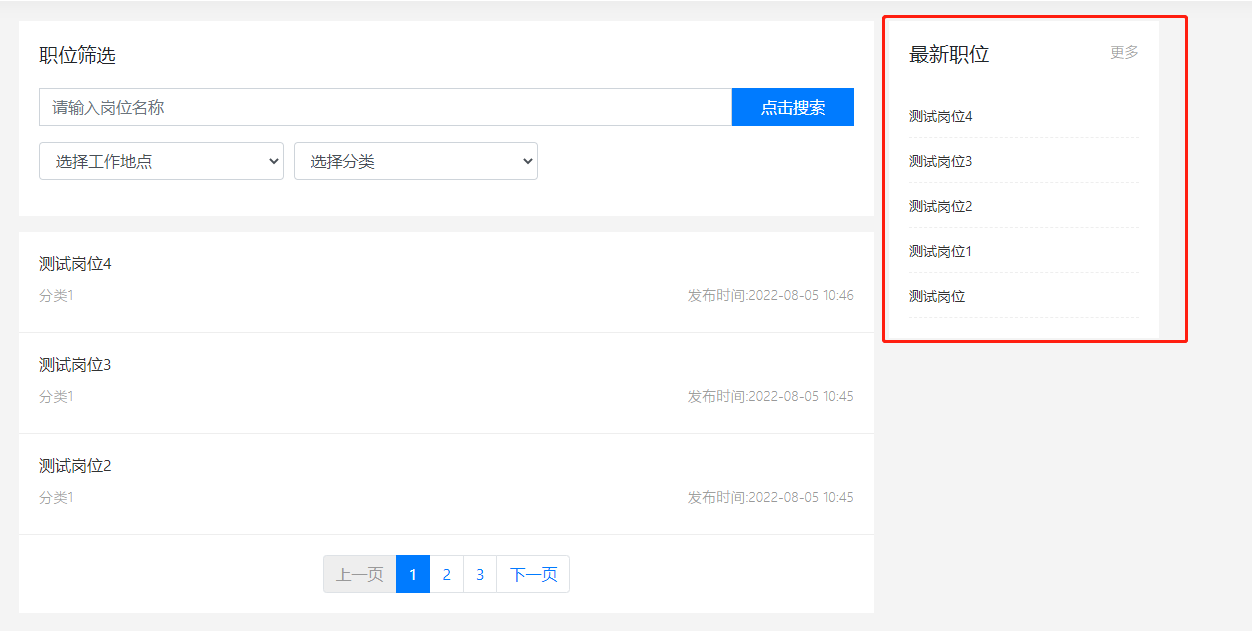
# #jobs() 中支持的参数有:
- categoryId:岗位分类ID
- deptId:岗位部门ID
- addressId:岗位地区ID
- education:学历 tinyint类型 支持 0~7 分别代表 0-不限制学历,1-初中及以下,2-中专/中技术,3-高中,4-大专,5-本科,6-硕士,7-博士
- workYear:工作年限 tinyint类型 支持 0~7 分别代表 0-不限制,1-在校生,2-应届生,3-一年以内,4-1~3年,5-3~5年,6-5~10年,7-10年以上
- workType:工作类型 tinyint类型 支持 0~2 分别代表 0-全职,1-兼职,2-钟点工
- recruitmentType:招聘类型 tinyint类型 支持0~2 分别代表 0-社招,1-校招,2-实习
- orderBy:根据属性进行排序 例如 "id desc"
- count:需要查询的数量
- 此指令查出的对象中,内置了category,address对象
# #jobPage() 指令的用法
- 此指令 #jobPage() 只能用在岗位列表页
<div>
#jobPage(pageSize = 1)
#for(job : jobPage.list)
<a href="#(job.url ??)">
岗位标题是:#(job.name ??)
</a>
<div>
岗位的描述是:#maxLength(job.summary,100)
</div>
#end
#jobPaginate()
#for(page : pages)
<a class="page-link" href="#(page.url ??)">
#(page.text ??)
</a>
#end
#end
#end
</div>
2
3
4
5
6
7
8
9
10
11
12
13
14
15
16
17
18
19
20
21
22
23
24
此指令 用于岗位列表页:joblist.html 需在对应的 controller 中传入 categoryId,addressId,education,workYear,recruitmentType,workType,title 等 信息
用法与 #articlePage() 类似 指令 #jobPage() 内部又包含了另一个指令 #jobPaginate(),#jobPaginate()是用于显示上一页和下一页
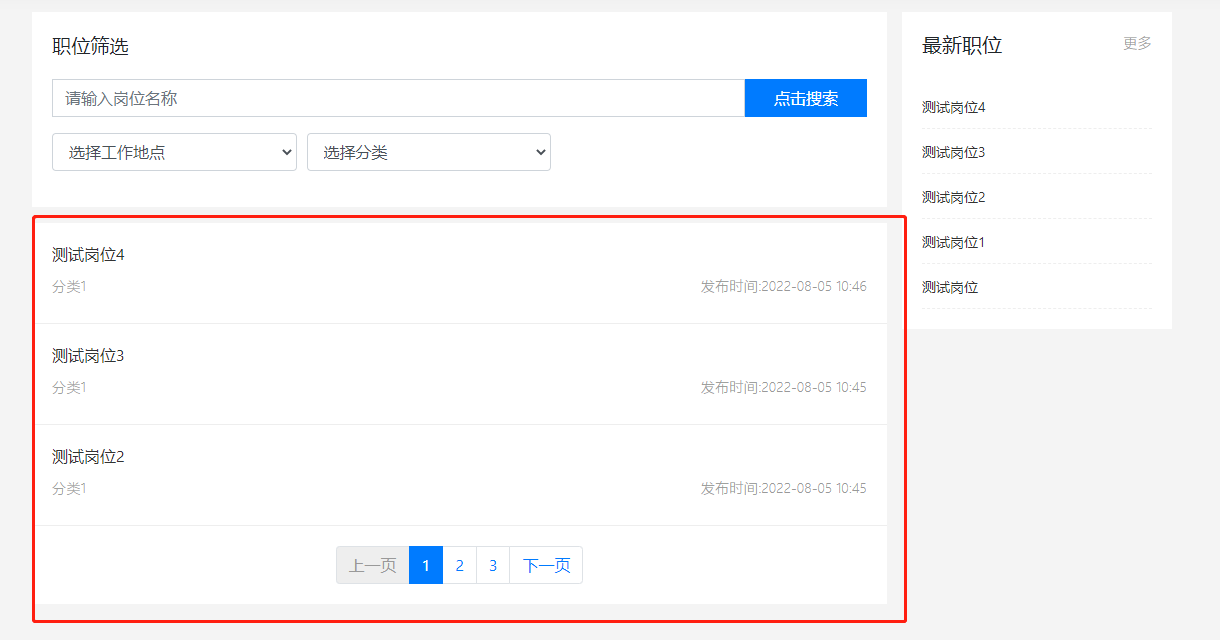
# #jobPage() 支持的参数有
- pageSize 用来指定当前页面有多少条数据,默认值为10,也就是不填写这个参数的话,默认为10条数据
- orderBy 根据属性进行排序 例如 "id desc"
- 此指令查出的对象中,内置了category,address对象
# 分页指令 #jobPaginate() 的参数有
- previousClass :上一页的样式,默认值:previous
- nextClass :下一页的样式,默认值:next
- activeClass :当前页面的样式,默认值:active
- disabledClass :禁用的样式(当下一页没有数据的时候,会使用此样式),默认值:disabled
- anchor :锚点链接
- onlyShowPreviousAndNext :是否只显示上一页和下一页(默认值为false,一般情况下在手机端才会把这个值设置true)
- previousText :上一页按钮的文本内容,默认值:上一页
- nextText :下一页按钮的文本内容,默认值:下一页
- firstGotoIndex : 是否让第一页进入首页,默认值:false
# 页面相关指令:
| 指令名称 | 可用页面 | 描述 |
|---|---|---|
| #page() | 任意 | 用于读取某个页面相关信息 |
| #pageList() | 任意 | 用于读取相关页面列表 |
| #pages() | 任意 | 用于读取某个页面列表 |
| #pageCommentPage() | page列表页:pagelist.html,page详情页:page.html | 获取评论列表 分页展示 |
# #page() 的使用
- 用于读取某个页面相关信息
示例:
<div>
#page(slug = "ces")
#(page.title ??)
#end
</div>
2
3
4
5
6
7
8
此时 就会根据提供的信息 查询相关的页面数据 返回一个 名为 page 的 page 对象
输出: <div>测试页面</div>
# #page() 支持的参数有
- slug:页面的 slug
# #pageList() 的使用
- 用于读取相关页面列表并分页显示
示例:
<div>
#pageList(pageSize = 2,orderBy="id desc",categoryId = 1)
#for(page : singlePages.list)
<p>#(page.title ??)</p>
#end
#end
</div>
2
3
4
5
6
7
8
9
10
11
12
此时就会根据 提供的信息 查询相关列表数据 返回 名为 singlePages 的 page 分页对象
使用 singlePages.list 可获取其中的 list 对象
# #pageList() 支持的参数有
- pageSize 用来指定当前页面有多少条数据,默认值为10,也就是不填写这个参数的话,默认为10条数据
- orderBy 根据属性进行排序 例如 "id desc"
- categoryId:分类ID
# 分页指令#pagePaginate() 的参数有
- previousClass :上一页的样式,默认值:previous
- nextClass :下一页的样式,默认值:next
- activeClass :当前页面的样式,默认值:active
- disabledClass :禁用的样式(当下一页没有数据的时候,会使用此样式),默认值:disabled
- anchor :锚点链接
- onlyShowPreviousAndNext :是否只显示上一页和下一页(默认值为false,一般情况下在手机端才会把这个值设置true)
- previousText :上一页按钮的文本内容,默认值:上一页
- nextText :下一页按钮的文本内容,默认值:下一页
- firstGotoIndex : 是否让第一页进入首页,默认值:false
# #pages() 的使用
- 用于读取某个页面列表
示例:
<div>
#pages(flag="jpress")
#for(page : pages)
<p>#(page.title ??)</p>
#end
#end
</div>
2
3
4
5
6
7
8
9
10
11
12
此时就会根据 提供的信息 查询相关列表数据 返回 名为 pages 的 list 对象
# #pages() 支持的参数有
- flag:页面标识
# #pageCommentPage() 的使用
- 获取评论列表 分页展示
示例:
<div>
#pageCommentPage(pageSize = 5)
#for(comment : commentPage)
<p>#(comment.content ??)</p>
#end
#end
</div>
2
3
4
5
6
7
8
9
10
11
12
此时就会根据 提供的信息 来查询 相关的评论内容 返回名为 commentPage 的对象
因为 此指令只能 用在
pagelist.html或者page.html页面 所以需要在对应的 controller 中设置一个 page 对象 否则数据为 null用法与 #articlePage() 类似 指令 #pageCommentPage() 内部又包含了另一个指令 #pageCommentPaginate(),#pageCommentPaginate()是用于显示上一页和下一页
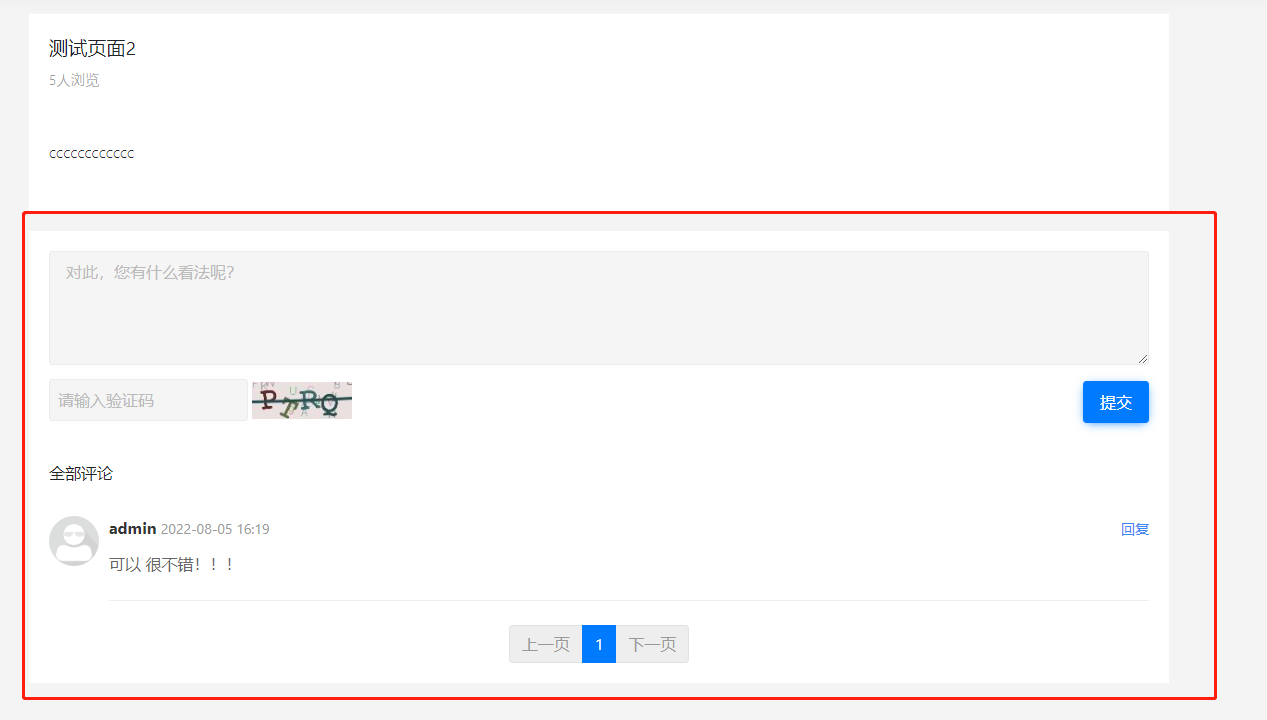
# #pageCommentPage() 支持的参数有
- pageSize 用来指定当前页面有多少条数据,默认值为10,也就是不填写这个参数的话,默认为10条数据
# 分页指令#pageCommentPaginate() 的参数有
- previousClass :上一页的样式,默认值:previous
- nextClass :下一页的样式,默认值:next
- activeClass :当前页面的样式,默认值:active
- disabledClass :禁用的样式(当下一页没有数据的时候,会使用此样式),默认值:disabled
- anchor :锚点链接
- onlyShowPreviousAndNext :是否只显示上一页和下一页(默认值为false,一般情况下在手机端才会把这个值设置true)
- previousText :上一页按钮的文本内容,默认值:上一页
- nextText :下一页按钮的文本内容,默认值:下一页
- firstGotoIndex : 是否让第一页进入首页,默认值:false
# 商品相关指令:
| 指令名称 | 可用页面 | 描述 |
|---|---|---|
| #allProductCategories() | 任意 | 获取商品的所有分类信息 |
| #categoryProducts() | 任意 | 读取某个分类下的商品列表 |
| #nextProduct() | 商品详情页:product.html | 读取下一个商品 |
| #previousProduct() | 商品详情页:product.html | 读取上一个商品 |
| #productCategories() | 任意 | 用于读取某一个商品的所属分类列表 |
| #productCommentPage() | 商品列表页:prolist.html,商品详情页:product.html | 获取评论列表 分页展示 |
| #product() | 任意 | 获取某个商品信息 |
| #productPage() | 任意 | 获取商品信息 分页显示 |
| #products() | 任意 | 获取商品列表 |
| #productSearchPage() | 商品搜索页:prosearch.html | 商品显示搜索结果 |
| #productTags() | 任意 | 获取所有 标签 的信息 |
| #relevantProducts() | 任意 | 获取该商品相关的商品列表 |
# #allProductCategories() 的使用
- 获取商品的所有分类信息
<div>
#allProductCategories(flag = "jpress",parentFlag="jpress",parentId=1,asTree=false)
#for(category : categories)
<p>#(category.title ??)</p>
#end
#end
</div>
2
3
4
5
6
7
8
9
10
11
12
此时 就会根据提供的信息 查询所有分类的数据 返回名为 categories 的 list 对象
# #allProductCategories() 支持的参数有
- flag:文章标识
- parentFlag:父级文章标识
- parentId:父级ID
- isTree 是否以树状的数据格式返回,默认是false,返回全部分类,可通过 item.childs 方式获取子级分类列表
# #categoryProducts() 的使用
- 读取某个分类下的商品列表
示例:
<div>
#categoryProducts(categoryId = 1,categoryFlag = "jpress",hasThumbnail = false,orderBy="id desc",count = 1)
#for(product : products)
<p>#(product.title ??)</p>
#end
#end
</div>
2
3
4
5
6
7
8
9
10
11
12
此时 会根据提供的条件查询文章信息 并返回一个名为 products 的 list 对象
# #categoryProducts() 中支持的参数:
- categoryId:商品分类的ID
- categoryFlag:商品分类的标识
- hasThumbnail:是否有缩略图 boolean类型
- orderBy:根据属性进行排序 例如 "id desc"
- count:需要查询的数量
# #previousProduct() 的使用
- 读取下一个商品
示例:
<div>
#previousProduct()
<p>#(next.title ??)</p>
#end
</div>
2
3
4
5
6
7
8
此时 会根据提供的条件查询文章信息 并返回一个名为 next 的 product 对象
因为此指令只能 用在商品详情页:
product.html所以需要在对应的 controller 中 设置一个 名为 product 的 product 对象
# ##previousProduct()() 的使用
- 读取下一个商品
示例:
<div>
##previousProduct()()
<p>#(previous.title ??)</p>
#end
</div>
2
3
4
5
6
7
8
此时 会根据提供的条件查询文章信息 并返回一个名为 previous 的 product 对象
因为此指令只能 用在商品详情页:
product.html所以需要在对应的 controller 中 设置一个 名为 product 的 product 对象
# #productCategories() 的使用
- 用于读取某一个商品的所属分类列表
示例:
<div>
#productCategories(1,"category")
#for(category : categories)
#(category.title ??)
#end
#end
</div>
2
3
4
5
6
7
8
9
10
11
12
此时 会根据传入的信息 查询 文章的分类信息 返回名为 categories 的 list 对象
# #productCategories() 支持的参数有
- 参数一:文章ID
- 参数二:分类的 type
# #productCommentPage() 的使用
- 获取评论列表 分页展示
示例:
<div>
#productCommentPage(pageSize = 5)
#for(comment : commentPage)
<p>#(comment.content ??)</p>
#end
#end
</div>
2
3
4
5
6
7
8
9
10
11
12
此时就会根据 提供的信息 来查询 相关的评论内容 返回名为 commentPage 的对象
因为 此指令只能 用在
productlist.html或者product.html页面 所以需要在对应的 controller 中设置一个 product 对象 否则数据为 null用法与 #articlePage() 类似 指令 #productCommentPage() 内部又包含了另一个指令 #productCommentPaginate(),#productCommentPaginate()是用于显示上一页和下一页

# #productCommentPage() 支持的参数有
- pageSize 用来指定当前页面有多少条数据,默认值为10,也就是不填写这个参数的话,默认为10条数据
# 分页指令#productCommentPaginate() 的参数有
- previousClass :上一页的样式,默认值:previous
- nextClass :下一页的样式,默认值:next
- activeClass :当前页面的样式,默认值:active
- disabledClass :禁用的样式(当下一页没有数据的时候,会使用此样式),默认值:disabled
- anchor :锚点链接
- onlyShowPreviousAndNext :是否只显示上一页和下一页(默认值为false,一般情况下在手机端才会把这个值设置true)
- previousText :上一页按钮的文本内容,默认值:上一页
- nextText :下一页按钮的文本内容,默认值:下一页
- firstGotoIndex : 是否让第一页进入首页,默认值:false
# #product() 的使用
- 获取某个商品信息
示例:
<div>
#product("1")
<p>#(product.title ??)</p>
#end
</div>
2
3
4
5
6
7
8
此时会根据提供的信息 查询对应的 produce 数据 返回名为 product 的 product 对象
# #produce() 支持的参数有
- 参数一: 商品ID 或者 商品 slug
# #productPage() 的使用
- 用于读取相关页面列表并分页显示
示例:
<div>
#productPage(pageSize = 2,orderBy="id desc",categoryId = 1)
#for(product : productPage.list)
<p>#(product.title ??)</p>
#end
#end
</div>
2
3
4
5
6
7
8
9
10
11
12
此时就会根据 提供的信息 查询相关列表数据 返回 名为 productPage 的 page 分页对象
使用 productPage.list 可获取其中的 list 对象
# #productPage() 支持的参数有
- pageSize 用来指定当前页面有多少条数据,默认值为10,也就是不填写这个参数的话,默认为10条数据
- orderBy 根据属性进行排序 例如 "id desc"
- categoryId:分类ID
# 分页指令#productPaginate() 的参数有
- previousClass :上一页的样式,默认值:previous
- nextClass :下一页的样式,默认值:next
- activeClass :当前页面的样式,默认值:active
- disabledClass :禁用的样式(当下一页没有数据的时候,会使用此样式),默认值:disabled
- anchor :锚点链接
- onlyShowPreviousAndNext :是否只显示上一页和下一页(默认值为false,一般情况下在手机端才会把这个值设置true)
- previousText :上一页按钮的文本内容,默认值:上一页
- nextText :下一页按钮的文本内容,默认值:下一页
- firstGotoIndex : 是否让第一页进入首页,默认值:false
# #products() 的使用
- 查询商品列表
示例:
<div>
#products(flag = "xxx",style = "xxx",hasThumbnail = false,orderBy = "id desc",count = 1)
#for(product :products)
#(product.title ??)
#end
#end
</div>
2
3
4
5
6
7
8
9
10
11
12
此时 会根据提供的条件查询文章信息 并返回一个名为 products 的 list 对象
# #products() 中支持的参数:
- flag:商品 flag(标识)
- style:商品 style(样式)
- hasThumbnail:是否有缩略图 boolean类型
- orderBy:根据属性进行排序 例如 "id desc"
- count:需要查询的数量
# #productSearchPage() 的使用
- 用户显示商品搜索结果
示例:
<div>
#productSearchPage()
#for(product : productPage.list)
<div class="ll-card">
<div class="row">
<div class="col-lg-3 col-md-3 col-sm-12 ll-card-image">
<a href="#">
<img src="#(product.thumbnail ?? 'img/default-img.jpg')" class="img-fluid"
alt="#(product.title ??)">
</a>
</div>
<div class="col-lg-9 col-md-9 col-sm-12 ll-card-main">
<a href="#(article.url ??)">
<div>
<h3 class="ll-card-main-title">
#(product.title ??)
</h3>
<p class="ll-card-main-info">
#maxLength(product.text,100)
</p>
</div>
<div class="ll-card-tag">
<div><i class="fa fa-clock-o"></i>#date(product.created)</div>
<div><i class="fa fa-eye"></i>#(product.view_count)</div>
<div><i class="fa fa-commenting-o"></i>#(product.comment_count)</div>
</div>
</a>
</div>
</div>
</div>
#end
#productSearchPaginate(firstGotoIndex=true)
<nav aria-label="Page navigation example">
<ul class="pagination justify-content-center ">
#for(page : pages)
<li class="page-item #(page.style ??)">
<a class="page-link" href="#(page.url ??)">
#(page.text ??)
</a>
</li>
#end
</ul>
</nav>
#end
#end
</div>
2
3
4
5
6
7
8
9
10
11
12
13
14
15
16
17
18
19
20
21
22
23
24
25
26
27
28
29
30
31
32
33
34
35
36
37
38
39
40
41
42
43
44
45
46
47
48
49
50
51
此指令 用于搜索结果页:prosearch.html 需在对应的 controller 中传入 keyword(搜索关键字) 以及 page(页码) 信息
用法与 #articlePage() 类似 也同样 内部又包含了另一个指令 #productSearchPaginate(),#productSearchPaginate()是用于显示上一页和下一页
# #productSearchPage() 支持的参数有
- pageSize:用来指定当前页面有多少条数据,默认值为10,也就是不填写这个参数的话,默认为10条数据
# 分页指令 #productSearchPaginate() 的参数有
- previousClass :上一页的样式,默认值:previous
- nextClass :下一页的样式,默认值:next
- activeClass :当前页面的样式,默认值:active
- disabledClass :禁用的样式(当下一页没有数据的时候,会使用此样式),默认值:disabled
- anchor :锚点链接
- onlyShowPreviousAndNext :是否只显示上一页和下一页(默认值为false,一般情况下在手机端才会把这个值设置true)
- previousText :上一页按钮的文本内容,默认值:上一页
- nextText :下一页按钮的文本内容,默认值:下一页
- firstGotoIndex : 是否让第一页进入首页,默认值:false
# #productTags() 的使用
- 获取所有 标签 的信息
示例:
<div>
#productTags(orderBy = "id desc",count = 1)
#for(tag :tags)
#(tag.title ??)
#end
#end
</div>
2
3
4
5
6
7
8
9
10
11
12
此时就会根据 提供的信息 查询标签信息 返回名为 tags 的 list 对象
输出:<div>标签1</div>
# #productSearchPage() 支持的参数有
- orderBy:根据属性进行排序 例如 "id desc"
- count:需要查询的数量
# #relevantProducts() 的使用
- 获取相关的商品列表
示例:
<div>
#relevantProducts(product,2)
#for(product :relevantProducts)
#(product.title ??)
#end
#end
</div>
2
3
4
5
6
7
8
9
10
11
12
此时就会根据 提供的信息 查询商品信息 返回名为 relevantProducts 的 list 对象
# #relevantProducts() 支持的参数有
- 参数一:商品对象
- count:需要查询的数量